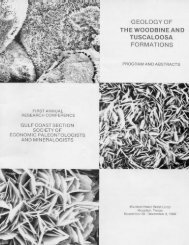Petroleum Systems of Deep-Water Basins - Gulf Coast Section SEPM
Petroleum Systems of Deep-Water Basins - Gulf Coast Section SEPM
Petroleum Systems of Deep-Water Basins - Gulf Coast Section SEPM
You also want an ePaper? Increase the reach of your titles
YUMPU automatically turns print PDFs into web optimized ePapers that Google loves.
Processes and Events in the Terrane Assembly <strong>of</strong><br />
Trinidad and Eastern Venezuela<br />
James Pindell<br />
Tectonic Analysis, Ltd.,<br />
Cokes, Barn, West Burton<br />
West Sussex RH20 1HD<br />
England<br />
Also: Dept. Earth Science, Rice University, Houston, Texas, USA<br />
e-mail: jim@tectonicanalysis.com<br />
Lorcan Kennan<br />
Tectonic Analysis, Ltd.<br />
Cokes, Barn, West Burton<br />
West Sussex RH20 1HD<br />
England<br />
Abstract<br />
Neogene-Recent arrival <strong>of</strong> the Caribbean plate and subsequent development <strong>of</strong> the southern Caribbean plate<br />
boundary zone as well as coeval deposition <strong>of</strong> Orinoco deltaic sediments in Eastern Venezuela-Trinidad have pr<strong>of</strong>oundly<br />
changed the region’s earlier basin setting, including some very large vertical and horizontal displacements <strong>of</strong><br />
original tectonic elements and depositional systems. Plate kinematic analysis provides the geometric and temporal<br />
framework in which to see past these late developments and to deduce the region’s earlier paleogeographic evolution<br />
and constrains the primary setting, style, and timing <strong>of</strong> basement structure in the region’s shallow-water, and deepwater<br />
continental margins through time. Palinspastic restoration <strong>of</strong> deformations, terrane accretions, and sedimentary<br />
additions to the region’s continental areas back through time to the breakup <strong>of</strong> Pangea allows fine-tuning <strong>of</strong> the kinematics<br />
and prediction <strong>of</strong> parameters such as paleo-heatflow, paleo-sedimentary provenance, and aspects <strong>of</strong> source and<br />
reservoir potential.<br />
In Eastern Venezuela-Trinidad, Jurassic rifting has produced a serrated crustal margin, along which rift segments<br />
are oriented ~070° and separated by sinistral transfer zones at ~140°. A Late Jurassic-Cretaceous “passive” margin<br />
along the proto-Caribbean seaway developed above this basement, but sinistral shear between South American and<br />
Bahamian crusts along the Guyana Escarpment may have caused continued tectonism into Early Cretaceous, prior to<br />
truly passive margin Late Cretaceous source rock deposition. Paleogene convergence between North and South America<br />
caused uplift and erosion in Venezuela’s northern Serranía del Interior, the flyschoid depositional results <strong>of</strong> which<br />
are found in northern Trinidad. This is because the northern Trinidad depocenter, here called the Northern superterrane,<br />
was situated much closer to the Serranía at that time, as opposed to southern Trinidad. During Oligocene-middle<br />
Miocene arrival from the west and dextral-oblique arc-continent collision <strong>of</strong> Caribbean plate with the margin, the<br />
Northern superterrane strata have been translated east-southeast and imbricated with strata <strong>of</strong> the Southern superterrane,<br />
producing strong foredeep subsidence in the Maturín-early Southern basin.<br />
Coeval strike slip faults such as Coche-North <strong>Coast</strong> may have taken up some <strong>of</strong> the strike-slip component <strong>of</strong> the<br />
oblique relative motion. Since the end <strong>of</strong> middle Miocene, the southeast Caribbean plate boundary zone has been<br />
dominated by east-west simple shear and relatively minor north-south shortening and extension adjacent to faults. A<br />
3-stage model involving variable strain partitioning describes the tectonic and basin history <strong>of</strong> Eastern Venezuela and<br />
Trinidad for the last 12Ma. The various stages <strong>of</strong> development have produced exploration settings <strong>of</strong> different aspect<br />
across the greater Trinidad region.<br />
8

















